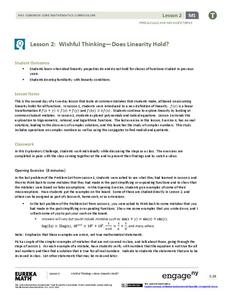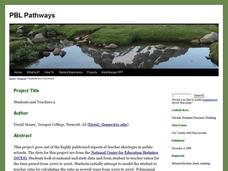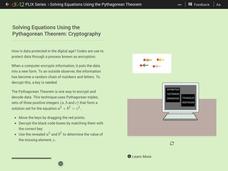CK-12 Foundation
Pascal's Triangle: Pyramid Blocks
Build a pyramid of sums. An interactive presents the first five rows of Pascal's Triangle as a pyramid. Pupils match missing entries in the pyramid and continue the pattern to determine entries of other rows. The learners use the entries...
BW Walch
Creating and Graphing Exponential Equations
Frequently found in biology and economic application problems, exponential equations show up as stars in this introductory presentation. Taking no background or knowledge of exponentials for granted, the slides walk learners through the...
CK-12 Foundation
Factorization of Quadratic Expressions: Algebra Tiles
What does it mean to factor the difference of two squares? The interactive presents an area model of the difference of two squares. Pupils rearrange the model to create a rectangular area. The learners determine the length and width...
CK-12 Foundation
Sums and Differences of Independent Random Variables: Traveling Seasickness
Use a Punnett square to calculate probabilities. The resource presents a situation in which two patients are randomly selected from a group of patients with a particular illness. Pupils use the interactive to determine the likelihood...
CK-12 Foundation
Expected Value: Creating a Discrete Probability Distribution Table
Wanna roll the dice? Determine whether it is a good idea to play a dice game. An interactive presents the rules for a game of dice. Pupils find the probabilities of each event and calculate the expected value of the game. They finish...
CK-12 Foundation
Sums of Geometric Series
Geometric series either get bigger or approach a single number. So, how do you know which it is? An interactive presents three different geometric series with varying common ratios. With the aid of patterns, pupils determine values of r...
EngageNY
Wishful Thinking—Does Linearity Hold? (Part 2)
Trying to find a linear transformation is like finding a needle in a haystack. The second lesson in the series of 32 continues to explore the concept of linearity started in the first lesson. The class explores trigonometric, rational,...
Curated OER
Rational Expressions: Simplifying
This two-day lesson will help the class simplifying rational expressions. It also has an emphasis on understanding when a rational expression is undefined. The lesson contains powerpoint presentations, worksheets, and answer key.
Illustrative Mathematics
Lake Algae
Introduce learners to exponential growth with this real-world problem about algae that is rapidly spreading across a lake in a city park. The task presents the rate of growth and an end value and asks learners to determine what happened...
EngageNY
Multiplying and Factoring Polynomial Expressions (part 1)
Polynomial multiplication and factoring go hand in hand. Why not teach them together. This resource begins with an area model for distributing a monomial and then connects the process to factoring the GCF. Learners then advance to...
EngageNY
Solving Basic One-Variable Quadratic Equations
Help pupils to determine whether using square roots is the method of choice when solving quadratic equations by presenting a lesson plan that begins with a dropped object example and asks for a solution. This introduction to solving by...
EngageNY
An Appearance of Complex Numbers 1
Complex solutions are not always simple to find. In the fourth lesson of the unit, the class extends their understanding of complex numbers in order to solve and check the solutions to a rational equation presented in the first lesson....
EngageNY
Complex Numbers as Vectors
Show your math class how to use vectors in adding complex numbers. Vectors represent complex numbers as opposed to points in the coordinate plane. The class uses the geometric representation to add and subtract complex numbers and...
EngageNY
When Can We Reverse a Transformation? 3
When working with matrix multiplication, it all comes back around. The 31st portion of the unit is the third lesson plan on inverse matrices. The resource reviews the concepts of inverses and how to find them from the previous two...
Balanced Assessment
A Run for Two
Develop a graph to represent the distance between two cars. The assessment task presents a scenario in which two cars are traveling at constant speeds with one faster than the other. Pupils develop graphical representations to show the...
PBL Pathways
Students and Teachers 2
Examine trends in student-to-teacher ratios over time. Building from the first task in the two-part series, classes now explore the pattern of student-to-teacher ratios using a non-linear function. After trying to connect the pattern to...
Teach Engineering
Common and Natural Logarithms and Solving Equations
Log some practice with logarithms. A PowerPoint presentation provides a tutorial on the change of base formula involving natural logarithms and solving exponential equations with logarithms in the fourth installment of a seven-part...
Curated OER
Thirty Exponential Application Problems
In this exponential worksheet, students solve thirty application problems. These problems cover compound interest, continuously compounded interest, and exponential growth models.
Noyce Foundation
The Shape of Things
Investigate the attributes of polygons. A thorough set of lessons presents problem scenarios for elementary through high school classes. The first lessons focus on basic characteristics of polygons, including the line of symmetry. As the...
Flipped Math
Multiply and Factor Polynomials
Gather together as a group for the best results. Pupils watch a video on how to use the distributive property to multiply polynomials. Scholars continue to watch as the presentation shows how to factor trinomials by grouping. Finally,...
Curated OER
Vectors: Follow That Arrow
Vectors and their connection to motion. A video will be presented to provide information for the class to use methods of solving vectors with and without grids. Real-world physical concepts will be explored in reference to vectors.
Curated OER
Translate Word Phrases and Sentences into Equations
Use this video to show your learners an example of how to translate word phrases into an equation to solve a real-world problem. The presenter begins with a review of how to use cross products to solve a proportion, including how to do...
CK-12 Foundation
Solving Problems by Factoring: Building a Doghouse
Building a doghouse is easier with a little mathematical help! Young scholars use sliders to adjust the length of the doghouse and watch as it affects the width and area. They then answer questions that help them discover the question...
CK-12 Foundation
Solving Equations Using the Pythagorean Theorem: Cryptography
Don't keep this resource a secret. Individuals learn to use the Pythagorean Theorem to find Pythagorean triples. They also see how Pythagorean triples can be useful in the field of cryptography to encrypt secret messages.
Other popular searches
- Present Continuous Tenses
- Simple Present Continuous
- Present Continuous Verbs
- Esl Present Continuous
- Present Continuous Verb Tense
- Esl Present Continuous Tense
- Present Continuous Charades
- Present Continuous Grammar
- Present Continuous Future
- Esl Present Continuous Poem
- Present Continuous Form
- Tense Present Continuous

























